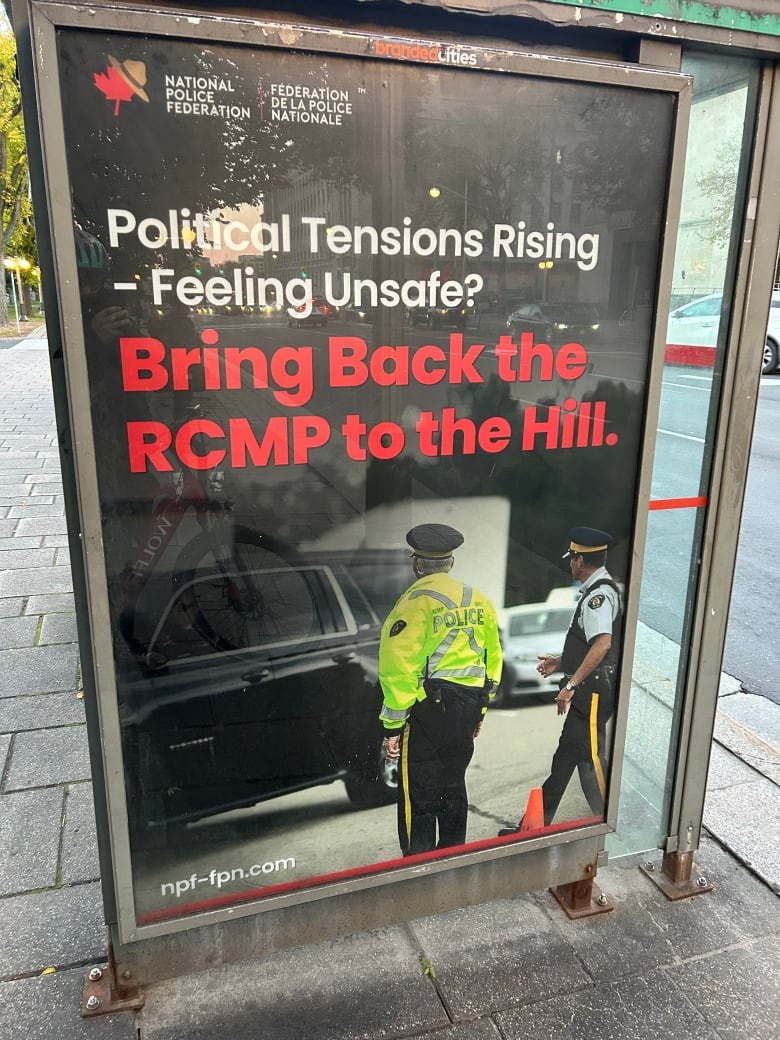
Ten years after a gunman died in a hail of bullets in Parliament’s Centre Block, security on Parliament Hill is noticeably different — but the debate over how to safeguard Canada’s national legislature is still going strong.
The National Police Federation (NPF), the union that represents the RCMP, has been highly critical of the decision to end the RCMP’s responsibility for policing the grounds outside the Parliament buildings.
The NPF has paid for ads in bus shelters across Ottawa asking passengers if they feel safe and suggesting governments ought to “bring back the RCMP to the Hill.”
Today marks the tenth anniversary of the Parliament Hill shootings, when a gunman killed ceremonial guard Cpl. Nathan Cirillo at the National War Memorial and then stormed Centre Block. A review conducted after that attack found that limited communication between multiple police forces in Ottawa created an atmosphere of confusion.
The shooting led to a shakeup in Parliament Hill security. The RCMP was replaced by the newly created Parliamentary Protective Service (PPS), an armed independent security force responsible for protecting the grounds and the Parliament buildings themselves.
Despite its independence, the PPS is overseen by a director who must be an RCMP officer. That director reports to the Speakers of both houses of Parliament and, on operational matters, to the RCMP commissioner.
Before the PPS was created, the House of Commons and the Senate each had their own protective services responsible for security inside their respective buildings.
An Ontario Provincial Police report on security on Parliament Hill drafted in the wake of the shootings concluded that security on the Hill needed to be simplified.
“The working relationship between the House of Commons Security Service, the Senate Protective Services and the RCMP is inadequate,” that report said. “All three agencies work as separate entities, with limited interaction or sharing of information.”
The three agencies also used different radio systems, making communication “a major issue during this incident,” said the OPP report.
The PPS and the RCMP union at odds
While putting the PPS in sole charge of security both inside and outside of the buildings on Parliament Hill eliminated some of that siloing, the NPF continues to insist the PPS is not fit for purpose. The union says it wants to see the RCMP made responsible for security inside parliamentary precinct buildings and on the grounds.
The NPF points out that the PPS is a security service, not a police force. Its members are not trained as police officers and they do not have the power to arrest people. PPS members are armed and can detain individuals but they must call on Ottawa police to make arrests.
Dennis Miller, vice president of the NPF, told CBC News the PPS also doesn’t take part in intelligence-sharing arrangements among police forces, something he said compromises security on the Hill.
“They’ve been trained as, for lack of other terms, security guards. They hold a post,” he said. “There’s no training in relation to bodyguarding, there’s no training in relation to individual protection.”

The union says the RCMP could replace the PPS with a force of 200 to 300 trained officers with the power to arrest, and could call in more Mounties rapidly in case of an incident.
“If the RCMP had 300 bodies at the Hill and the convoy were to happen again today, with those 300 bodies on the hill, it’s a one stop shop,” Miller said, referring to the massive protest that locked down much of downtown Ottawa in 2022.
“The call is made, we’re mobilizing. So we would have had those 1,500 to 1,600 bodies extra that we brought in, mobilized in a few days versus weeks.”
RCMP Commissioner Mike Duheme, who was the first director of the PPS, disagrees. He said he hasn’t seen any operational security gaps and the relationship between the PPS and Ottawa city police appears to be working well.
“At the moment I think the structure is superb,” Duheme told Radio-Canada in a French language interview that aired on Sunday. “It has evolved a lot and is much more in line with demand today … Even with all the major events involving the integration of the PPS, it’s something that’s remarkable.”
This year’s federal budget pledged $50 million for the Ottawa Police Service over the next five years to enhance security near Parliament Hill.
The way Parliament operates from day to day has also changed since the events of October 22, 2014.
The Speaker of the House at the time of Michael Zehaf-Bibeau’s attack, Conservative MP Andrew Scheer, told a parliamentary committee in November 2014 that additional security posts had been installed outside Centre Block to conduct pre-screening of visitors.
He also said tours during caucus meetings, when the halls of Parliament can be filled with MPs and staff members, had been cancelled, the size of tours themselves had been reduced and doors to Parliament were being locked after business hours.
An official from the House Speaker’s office told CBC News those measures are still in place today. A spokesperson for the PPS would not discuss them.
“Since the establishment of the PPS, overall security on Parliament Hill and within the Parliamentary Precinct has been enhanced from a technical, tactical and infrastructural perspective,” the agency said.
“For security reasons, we cannot provide details about our operations, features or capabilities.”